|
- Interim Update 6th June 2012
Copyright
Reminder
The commentaries that appear at TSI
may not be distributed, in full or in part, without our written permission.
In particular, please note that the posting of extracts from TSI commentaries
at other web sites or providing links to TSI commentaries at other web
sites (for example, at discussion boards) without our written permission
is prohibited.
We reserve the right to immediately
terminate the subscription of any TSI subscriber who distributes the TSI
commentaries without our written permission.
Monetary union
impossible without fiscal union?
The following paragraph was part of John Hussman's
latest weekly commentary:
"The problems in Europe reflect the impossibility of having a currency union without having a fiscal union, and even 94% agreement among European countries on Eurobonds or other approaches is not sufficient if the 6% holdout happens to be Germany, which is being called on to finance endless transfers and allow money to be permanently printed in order subsidize debt-strapped neighbors."
We agree with the bulk of Hussman's writings, but we totally disagree with his assertion that a currency union is impossible without a fiscal union. This assertion has no logical basis and is refuted by the historical record. We note, in particular, that there were long periods in the distant past when different countries that were not fiscally united were able to simultaneously and successfully use a common currency (gold).
What the problems in Europe actually reflect is the impossibility of a central planning agency setting monetary policy for a large group of fiscally disparate countries. In other words, the problem isn't the common currency, it's the central control of the common currency.
This problem (central control of the money supply and interest rates) applies everywhere, not just Europe. Moreover, it would still apply in Europe if a fiscal-political union existed. It's just that in the absence of a fiscal-political union the problem, a manifestation of which is government insolvency due to unrestrained borrowing and spending, becomes blatantly obvious much sooner. In the US, for example, the partnership of the Federal Reserve and the Federal government ensures that the Federal government will be able to continue its borrowing and spending despite its readily apparent insolvency. The buyers of US Treasury securities aren't worried about direct default because if 'push came to shove' the Fed, with its infinitely deep pockets, would be there to purchase every bond issued by the government.
To further explain, the Fed's main purpose is to serve (support the borrowing and spending of) a single government. It will therefore never run into a conflict of interest. The ECB, on the other hand, is supposed to serve 17 independent governments, an objective that has become unachievable now that huge differences have emerged between the monetary demands of these governments. It is no longer possible, for example, for the ECB to simultaneously serve the governments of Greece and Germany.
Even if Europe ends up with some sort of "fiscal union", a total collapse of the euro is likely to occur well ahead of a total collapse of the US$. This is because it won't be a true fiscal union. The people of one European country won't fall into line with the dictates handed down by representatives of another European country, especially when the dictates result in short-term pain.
The Stock Market
Stock markets rebounded strongly on Wednesday 6th June. Bears will point out that sharp 1-2 day rallies regularly occur during bear markets, which is true. However, sustained upward reversals tend to begin the same way, so at this stage the price action doesn't distinguish between a short/sharp bounce within a continuing decline or the start of a tradable advance.
We suspect that the highs for the year are in place, but that the indices are sufficiently 'oversold' to cause the direction of least resistance to be up for 2-4 weeks.
With regard to likely targets for the multi-week rebound that appears to have just begun, we cite the tendency of downward-trending markets to return to their 50-day moving averages. This suggests rebound targets of around 240 for the Dow Jones World Index (DJW) and around 1350 for the S&P500 Index (SPX). Here are the relevant daily charts:
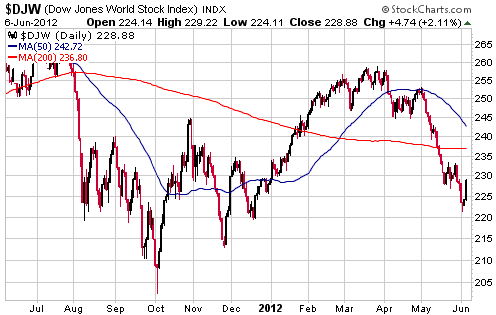
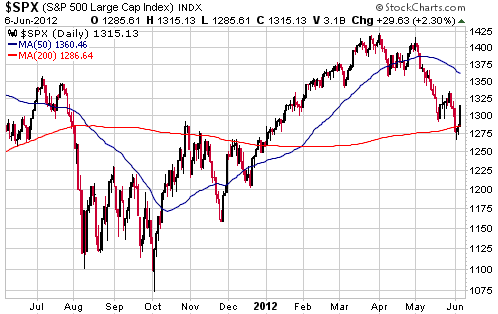
Gold and the Dollar
Gold
It is unlikely that there will be a new round of "QE" in the US in the near future. There will have to be a lot more weakness in the stock market and the backward-looking economic data first. A gold rally at this time on the back of hopes/fears about more QE therefore won't get very far.
We don't know that anticipation of more QE is behind the gold reversal of the past two weeks, but we've recently seen many articles that broach the possibility of the Fed cranking up its printing presses. This is despite it now being widely understood that "QE2" gave the stock market a temporary boost but was not the slightest bit helpful to the economy. It is also despite the fact that US government bond yields are already at all-time lows.
Our point is that predictions of gold rocketing upward over the next few months on the back of a new Fed QE program should be treated with a liberal dose of scepticism.
That being said, the gold rally probably has further to go. Considering the extent to which the market recently became 'oversold' it will be surprising, for instance, if the price doesn't at least return to the high-$1600s over the weeks ahead. However, at this stage it is prudent to view this rally as a rebound within a continuing correction/consolidation.
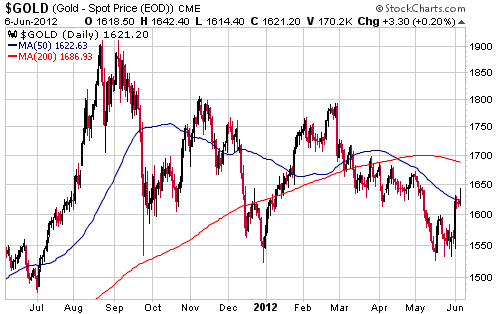
With regard to developments that could transform a routine gold rebound into something much bigger, the near-term introduction by the Fed of another QE program is a long-shot. A potential development with a higher probability is a worsening of the euro-zone's financial predicament, leading to widespread fear that Europe's monetary union is about to disintegrate and/or that some of Europe's most important banks are about to go bust. There's only a small chance that Europe's monetary union will actually disintegrate in 2012, but it isn't hard for us to imagine that fear of such an outcome could build over the next few months as Europe's leaders argue about what should be done while doing nothing constructive.
Gold Stocks
HUI Scenarios
Although it is too early to conclude with certainty that an intermediate-term bottom was set last month, evidence in support of such a conclusion continues to mount. A good way to put it is: considering that our evidence is limited by the fact that the rally from the low is only about three weeks old, we are as sure as we can be that an intermediate-term bottom is in place.
We will continue to make buy/sell decisions based on real-time assessments of risk versus reward, but we can't help having opinions on how the gold-stock story will unfold over the coming 12 months. These opinions are largely based on what happened following previous intermediate-term bottoms, especially those that occurred in May of 2004 and 2005. From most likely to least likely, here are three plausible HUI scenarios based on the assumption that an intermediate-term bottom is in place:
1. A 1-2 year upward trend has begun. There will be multi-week corrections of as much as 20% along the way, but the next intermediate-term peak (a peak that holds for more than 6 months) won't occur prior to May of 2013.
2. The HUI will trend upward to an intermediate-term peak in the final quarter of this year. It will then trend downward to an intermediate-term bottom in the second quarter of 2013, after which a 1-2 year upward trend will begin.
3. The rally that began in mid May will last 2-4 months and will be followed by a decline that leads to the HUI successfully testing its May low during October-November of this year. A 1-2 year upward trend will then begin.
Scenarios 1 and 2 are effectively the same between now and October. Under both of these scenarios the HUI would likely return to the mid-500s by October, at which point the paths would begin to diverge.
Scenario 3 is considered to be the least likely, for two reasons. First, within the context of what has happened over the past 12 years it would be unprecedented for the HUI to become as 'oversold' as it did in May and then return to its low only 6 months later. Second, the established pattern is for intermediate-term May lows to be followed by short-term or intermediate-term highs during October-November, and for intermediate-term October-November lows to be preceded by May highs. Up until now there has been no case of an intermediate-term May low being followed by an intermediate-term low during October-November of the same year.
Scenario 3 is still plausible, though, because it meshes with plausible scenarios elsewhere in the financial world. For example, it is not out of the question that there will be another frenzied de-leveraging during August-November of this year resulting in gold stocks being dumped along with most other assets in a mad scramble for cash.
Current Market Situation
The HUI has done better than expected over the past week, which, of course, makes a nice change. Whereas the initial rally from an intermediate-term low will often end near the 50-day MA, the HUI's initial rally has gone high enough that this MA could provide support during the next correction.
420-430 is a reasonable target for the next downward correction. This is irrespective of whether the initial rally has just peaked.
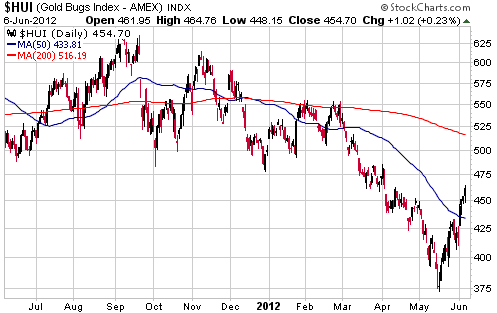
Currency Market Update
Three Years Ago
About 3 years ago (in the 8th July 2009 Interim Update, to be precise), we wrote the following:
"We expect that the next phase of the economic depression will put severe strain on Europe's monetary union due to differing perceptions amongst EMU members as to the appropriate monetary response to the downturn. Like the Fed, the ECB has virtually unlimited power to inflate the supply of currency. But whereas the Fed is effectively an agency of the US Government and stands ready to monetise any amount of US Federal debt should the perceived need arise, no individual country/government in the Euro Zone is free to inflate at will. Moreover, we get the impression that attitudes towards monetary inflation vary widely amongst countries sharing the euro, with anti-inflation Germany at one extreme and countries such as Italy, Spain and Greece at the other.
Large differences in attitudes towards monetary inflation will, we suspect, result in a type of "tug-o-war" between EMU members as the economic situation either deteriorates or stubbornly refuses to improve. It is possible that Germany will hold sway in this 'war', in which case the euro will become a relatively strong currency. A second possibility is that Germany will yield to the increasingly frenzied demands for easier money, causing the euro to gain ground against the US$ in their race to zero. A third possibility is that the Euro Zone will shrink, either because countries such as Italy and Spain break away in order to regain their monetary independence (the freedom to inflate at will) or because Germany breaks away -- and brings the Deutsche Mark back into existence -- in order to protect itself from a perceived hyperinflation threat."
In terms of economic and monetary fundamentals, it's amazing how little has changed over the intervening 3-year period. In terms of perception, however, there has been a big change. What we wrote three years ago was outlandish relative to popular opinion at the time, but it is now the mainstream view. Most people who keep up with the latest developments in economics and the financial markets now accept that Europe's monetary union is headed towards a major shake-up that will either involve ECB debt monetisation on a grand enough scale to enable the weakest countries to remain 'on board', or a contraction of the union. As we mentioned back in 2009, a contraction could occur via an exit by some economically weak countries or via an exit -- and return to the Deutsche Mark -- by Germany.
Of the above-mentioned options, massive debt monetisation would be the least difficult and disruptive in the short term. It would also lead to the greatest economic hardship on a long-term basis because it would penalise savers and distort the price signals that the market economy relies on.
Politicians and central bankers would never choose lesser short-term pain at the cost of greater long-term pain, would they?
Current Market Situation
With the stock market having begun to rebound, the Dollar Index has begun to pull back.
We don't have a strong opinion on how the Dollar Index will perform over the next couple of months, other than we expect it to trend in the opposite direction to the stock market. For example, if the stock market rebounds for 2-3 weeks before resuming its intermediate-term decline, then the Dollar Index will probably decline/consolidate for 2-3 weeks before resuming its intermediate-term advance.
The Dollar Index has intermediate-term upside potential to the mid-to-high 80s, but getting that high will require panic related to a large stock market decline and/or a breakup of the euro-zone.
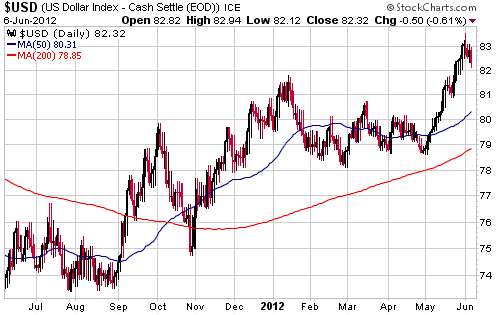
A weekly chart of the Yen is displayed below. The blue line on the chart is the 70-week moving average (MA).
The Yen's recent rebound went a little further than it was 'supposed' to go, but this week's downward reversal is evidence that the currency's intermediate-term decline has resumed.

Update
on Stock Selections
Notes: 1) To review the complete list of current TSI stock selections, logon at
http://www.speculative-investor.com/new/market_logon.asp
and then click on "Stock Selections" in the menu. When at the Stock
Selections page, click on a stock's symbol to bring-up an archive of
our comments on the stock in question. 2) The Small Stock Watch List is
located at http://www.speculative-investor.com/new/smallstockwatch.html
 Two poorly timed financings -- one necessary and one not Two poorly timed financings -- one necessary and one not
Junior uranium miner Energy Fuels (TSX: EFR) announced on Monday that it was raising $7M by issuing about 31M new shares at C$0.23/share. Also, each new share comes with half a 3-year C$0.265 warrant, meaning that the financing increases the fully diluted share count by about 47M. This represents 20% dilution based on the current fully-diluted share count and 7% dilution based on what the share count will be following the previously-announced purchase of Denison's US-based uranium assets. The 7% dilution figure is the relevant one because the financing announced this week is linked to the Denison purchase.
We never like it when our companies do equity financings when their shares are very undervalued and oversold. For that reason, we aren't pleased with EFR's decision to do an equity financing at this time. However, the financing is probably necessary for risk management purposes.
Once EFR completes its purchase of the White Mesa mill from Denison it will be a highly leveraged play on the uranium price. This will serve it well after the uranium price begins to trend upward, but it means that the company's bottom line will be more vulnerable to a decline in the uranium price than would have been the case if the company had remained a non-producer. A bigger cash cushion will lessen the risk that a decline in the uranium price will cause a major financial problem.
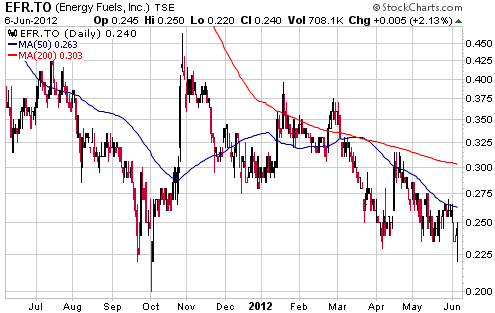
While the low-priced equity financing announced by EFR on Monday can be justified by risk management considerations, the same cannot be said about the low-priced financing announced by Sabina Gold and Silver (TSX: SBB) on Tuesday. Whereas EFR needs more cash to ensure that it doesn't run short over the next several months, SBB's existing $150M cash hoard makes it one of the world's most cash-rich exploration-stage gold miners. SBB's decision to raise an additional $30M by issuing new shares is therefore difficult to fathom.
On the positive side of the ledger, SBB's financing is being done at a 13% premium to the market price at the time of the announcement (due mainly to the flow-through nature of the financing) and doesn't involve any warrants. On the negative side of the ledger, the C$2.90/share financing price is very low relative to the stock's valuation and where it traded over much of the past 12 months.
There is clearly a reason for SBB's financing other than a need for cash. Perhaps it is being done to enable a large Canadian investor to buy a significant stake in the company.
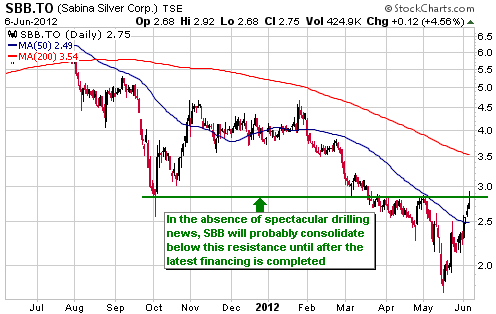
 Dragon Mining (ASX: DRA). Shares: 89M issued, 90M fully diluted. Recent price: A$0.75
Dragon Mining (ASX: DRA). Shares: 89M issued, 90M fully diluted. Recent price: A$0.75
As a result of the decline in its stock price, DRA's enterprise value is now less than half of its annual gold sales revenue. Even for a small-scale producer this is extraordinarily low, especially considering that the production is profitable and comes from a secure part of the world. The valuation is so low that we are beginning to wonder if there are problems that the company is not telling us. This is certainly possible, but it's more likely that DRA's valuation extreme is just the stock market being its inefficient, irrational self.
DRA is a buy near its current price.

Chart Sources
Charts appearing in today's commentary
are courtesy of:
http://stockcharts.com/index.html
http://bigcharts.marketwatch.com/

|

